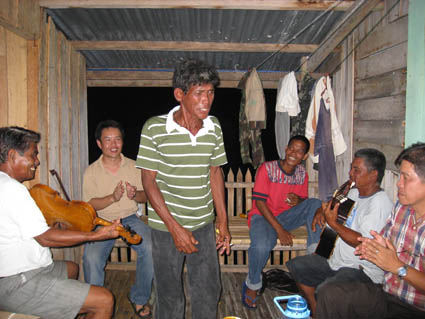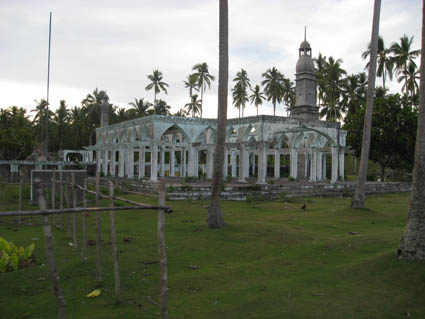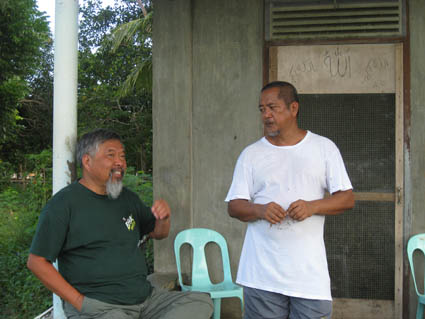
In the archipelago of Tawi-Tawi, Sibutu Island stands for two things. First, it is the home of “
ukkil†wood carvers and second, it is famous for boat making. “
Ukkil†is an ancient wood art ala Pampanga- or Paete-style sans images. The more elaborate “
ukkil†are seen in famous houses, mosques and burial grounds. The vine and flowery designs are believed to be as ancient as the Majapahit or the Sri Vijaya empires that connected the Southern Philippines culturally to its southern neighbors, Indonesia and Malaysia, prior to the coming of Islam. While the “
ukkil†art is found nearly in all the islands, the “real macoy†are made in Sibutu, because the people there are reputed to be the “custodians†of this “sacred artâ€. The other fame of the “islanders†is their expertise and mastery in boat-making. Big and small boats that navigate the Sulu Sea are “Made in Sibutuâ€. These boats are more popularly known as “
kumpitsâ€. Because of this technology, Sibutu has provided the peoples of Tawi-Tawi and Sulu the means to connect all the dots (islands and islets) in the Sulu Sea. They also build “modern†boats and speedboats that can compare with the very expensive fiber glass version. Sibutu has an advantage over the other islands because it grows all kinds of wood for all the timber needs of the province, from charcoal to light and hard timber for their boats and houses. Sibutu maintains its mystique for the simple fact that the remains of Sheik Karim Makhdum, the Arab missionary who introduced Islam, lie in the island. His tomb, a national historical site, is located in Tandu Banak. To some historians, this tomb may sound confusing since the people of Simunul also claim that their island is the locus not only of the first mosque built by the Sheik himself but also of his “real†tomb. The inhabitants point to the “miraculous†mound that has become a “
tampat†– a sacred place. We shall veer away from the many competing claims. Suffice to say that all these burial grounds are considered “
tampatâ€, including the one in Jolo. The people in Simunul believe in the legend that Karim Makhdum was a giant who could traverse the Sulu Sea on foot as he moved from island to island. The coral reefs during low tide actually connect the islands. The other possible explanation is the fact that Karim and Makhdum are really NOT proper names but the plural for “holy†and “learned†men. Is this a case of several holy and learned men, instead of only one historical person, who were responsible for the Islamization of Sulu and Tawi-Tawi? The acceptance of this theory could help explain the several burial grounds. They are all tombs of Karim Makhdum!

The people of the island have always been passionate for education. Way back in 1957, when the leaders heard of the Notre Dame schools in Jolo and Bongao under the Oblates of Mary Immaculate, they sent word to Bishop Francis McSorley, OMI, to establish one in Sibutu. For more than 50 years now, the Notre Dame of Sibutu has continuously produced competent boys and girls to pursue higher studies in Jolo, Bongao, Zamboanga City, and beyond. Through the years Notre Dame of Sibutu has produced many professionals who now serve as the backbone of both the public and private sectors in the province. The occasion for our visit was the celebration of the annual fiesta of St. Francis of Assisi, with Bishop Angelito Lampon, OMI as the main celebrant. Priests and parishioners from the neighboring island had also come to join in the festivities. The officers and men of the nearby Philippine Air Force base and the Philippine Marines, who are in-charge of the security of the group of islands that include Sibutu, were also in attendance. The most interesting small Christian community in the island is found in Barangay Tongehat. There are about 25 Christian families in the area who have found their livelihood as seaweed farmers in the coral reefs of Sibutu. Their Sama and Badjao neighbors have accepted them and they all live in peace. Living in peace in the area is something relative. This is due to the fact that the tiny Christian minority poses no threat to the local powers that be. Secondly, the powerlessness of the Christian minority makes them totally reliant on the “goodwill†of their majority neighbors. Thirdly, the Christians have to bear the label “Bisaya†with all its pejorative meaning dating back from the time of the slavery and piracy in the 17th and 18th centuries. The more educated inhabitants who had ventured outside and have returned to the island have seen the bigger picture that in this country, they are actually the minority and thus have more favorable and fresher outlook of the presence of the few Christians in the place. This openness to each other as neighbors and the respect that each one accords the other as part of sharing a common humanity are the real formula for living together as partners and co-citizens of the planet. In places where this type of openness and respect are absent, the people live “in fear and trembling†for the security of their person and livelihood. I was at Tongehat as the people celebrated the end of the fasting month of Ramadan. To my great surprise, the
barangay was fully alive with all kinds of festivities. They had volleyball and basketball competitions, and the barangay center was teeming with all kinds of other games – cards and dices! It was like any barangay in the Philippines celebrating a big “fiestaâ€. This spirit of celebration and the sheer joy of being together are perhaps the more enduring bonds that unite us together regardless of faiths, cultures and languages.

Fr. Raul Biasbas, OMI, the director of Notre Dame of Sibutu, was our good host during this visit. He invited everybody to the feast and they all came in their “wedding†garments. There was much singing and dancing during this annual fare. The old, young, and children came from all over and they celebrated their fiesta with great abundance. Food and drink also overflowed, especially with a wild pig courtesy of some men from the Air Force who went hunting the previous night. Sibutu is still famous for this kind of hunting. The several islands in Tawi-Tawi, like other places in the ARMM, can teach us a lesson or two about development and governance. The infrastructure projects put up by funding agencies are tragic examples of money gone down the drain. Halls, centers, and other infrastructures are pitiful sights. They are uncompleted, unserviceable and abandoned to rot. Likewise, the program support for local governments in the ARMM is in place through the now infamous internal revenue allotment or IRA, yet not a slightest dent has been made in the style as well as performance of the local government in the area. The people, who are not experts on development and governance, have expressed their dreams in only three things: first is livelihood; second is access to good basic education for their children; and last is access to other basic social services like health clinics with medical personnel and medicine, and potable water. While international donor agencies and LGUs think of big things, the three simple dreams of people remain unmet. Based on the look of things in the province now, the people must gird themselves for a very long wait for their simple dreams to be fulfilled! Tsk Tsk Tsk!





